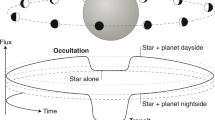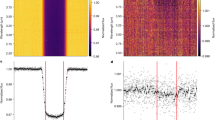Abstract
Titan is the only satellite in our Solar System with a dense atmosphere. The surface pressure is 1.5 bar (ref. 1) and, similar to the Earth, N2 is the main component of the atmosphere. Methane is the second most important component2, but it is photodissociated on a timescale of 107 years (ref. 3). This short timescale has led to the suggestion that Titan may possess a surface or subsurface reservoir of hydrocarbons4,5 to replenish the atmosphere. Here we report near-infrared images of Titan obtained on 26 October 2004 by the Cassini spacecraft. The images show that a widespread methane ocean does not exist; subtle albedo variations instead suggest topographical variations, as would be expected for a more solid (perhaps icy) surface. We also find a circular structure ∼30 km in diameter that does not resemble any features seen on other icy satellites. We propose that the structure is a dome formed by upwelling icy plumes that release methane into Titan's atmosphere.
This is a preview of subscription content, access via your institution
Access options
Subscribe to this journal
Receive 51 print issues and online access
$199.00 per year
only $3.90 per issue
Buy this article
- Purchase on Springer Link
- Instant access to full article PDF
Prices may be subject to local taxes which are calculated during checkout




Similar content being viewed by others
References
Lellouch, E. Atmospheric model of Titan and Triton. Ann. Geophys. 8, 653–660 (1990)
Kuiper, G. P. Titan: a satellite with an atmosphere. Astrophys. J. 100, 329–332 (1944)
Yung, Y. L., Allen, M. & Pinto, J. P. Photochemistry of the atmosphere of Titan: comparison between model and observations. Astrophys. J. Suppl. 55, 465–506 (1984)
Lunine, J. I. Does Titan have an ocean? A review of current understanding of Titan's surface. Rev. Geophys. 31, 133–149 (1993)
Lunine, J. I., Stevenson, D. J. & Yung, Y. L. Ethane ocean on Titan. Science 222, 1229–1230 (1983)
Sotin, C. & Tobie, G. Internal structure and dynamics of the large icy satellites. C.R. Acad. Sci. 5, 769–780 (2004)
Meier, R., Smith, B. A., Owen, T. C. & Terrile, R. J. The surface of Titan from NICMOS observations with the Hubble Space Telescope. Icarus 145, 462–473 (2000)
Brown, B. et al. Observations with the Visual and Infrared Mapping Spectrometer (VIMS) during Cassini's flyby of Jupiter. Icarus 164, 461–470 (2003)
Lucchita, B. K. Grooved terrains on Ganymede. Icarus 44, 481–501 (1980)
Sotin, C., Head, J. W. & Tobie, G. Europa: Tidal heating of upwelling thermal plumes and the origin of lenticulae and chaos melting. Geophys. Res. Lett. 29(8), doi:10.1029/2001GL013844 (2002)
Gibbard, S. G. et al. Titan's 2-µm surface albedo and haze optical depth in 1996–2004. Geophys. Res. Lett. 31, doi:10.1029/2004GL019803 (2004)
Acknowledgements
We thank E. Mercier, D. Mège, J.-P. Combe and O. Bourgeois for discussions about interpreting the high-resolution image, and R. Wagner for help in the projection of the cubes.
Author information
Authors and Affiliations
Corresponding author
Ethics declarations
Competing interests
Reprints and permissions information is available at npg.nature.com/reprintsandpermissions. The authors declare no competing financial interests.
Rights and permissions
About this article
Cite this article
Sotin, C., Jaumann, R., Buratti, B. et al. Release of volatiles from a possible cryovolcano from near-infrared imaging of Titan. Nature 435, 786–789 (2005). https://doi.org/10.1038/nature03596
Received:
Accepted:
Issue Date:
DOI: https://doi.org/10.1038/nature03596
This article is cited by
-
Science goals and new mission concepts for future exploration of Titan’s atmosphere, geology and habitability: titan POlar scout/orbitEr and in situ lake lander and DrONe explorer (POSEIDON)
Experimental Astronomy (2022)
-
On the Habitability and Future Exploration of Ocean Worlds
Space Science Reviews (2020)
-
Titan as Revealed by the Cassini Radar
Space Science Reviews (2019)
Comments
By submitting a comment you agree to abide by our Terms and Community Guidelines. If you find something abusive or that does not comply with our terms or guidelines please flag it as inappropriate.



